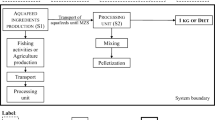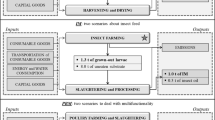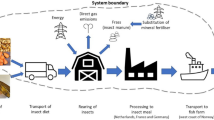Abstract
Purpose
This study performs an exploratory comparative evaluation of various animal and vegetable protein and lipid sources, used as feed in the aquaculture industry. The ingredients studied include fishmeal (FM) and fish oil (FO) from fisheries by-products, meal and fat by-products from poultry slaughter, FM and FO from Peruvian anchovy capture, and soybean meal and oil. The boundaries studied include the production or capture, the ingredient processing unit and the transport to the unit that processes the ingredients into aquafeeds in Portugal.
Methods
The LCA impact assessment method is the CML-IA baseline V3.04/EU25 and the results were obtained for the characterisation step. Some of the inventory data were collected from a Portuguese company (Savinor) that processes both by-products from local fisheries and by-products from poultry production. Savinor provided data specifically associated with the ingredients’ production. Obtained data were complemented with literature data from: fish capture and poultry production. Inventory data for the production of ingredients from Peruvian anchovy and soybeans were retrieved from literature. It was assumed that the transport of the ingredients produced from Peruvian anchovy, between Lima and Rotterdam, is made in a transoceanic vessel, and it is considered a transport by truck between Rotterdam and Ovar, for soybean ingredients and FM/FO produced from Peruvian anchovy.
Results and discussion
This paper shows that poultry meal and poultry fat from poultry slaughter by-products have the larger contribution to all environmental impact categories evaluated, being the production of poultry the life cycle stage that contributes most to the overall categories. On the other hand, FM and FO from Peruvian anchovy were the ingredients with a lower contribution to all impact categories, except for abiotic depletion category, for FM from Peruvian anchovy, and abiotic depletion, abiotic depletion (fossil fuels) and ozone layer depletion for FO from Peruvian anchovy. For these categories, soybean meal and oil had lower impacts, respectively. The ingredients were compared by classes (protein and lipid sources).
Conclusions
A general conclusion is that soybean meal and oil and FM/FO from Peruvian anchovy appear to be very interesting options for aquafeeds from an LCA perspective. However, some limitations identified for this study, as, for instance, that it does not account for the environmental benefits associated with the use of the mentioned by-products, that would otherwise be considered wastes (i.e. by-products from the fish canning sector and poultry slaughter) shall be evaluated in future studies.




Similar content being viewed by others
References
Almeida C, Vaz S, Cabral H, Ziegler F (2014) Environmental assessment of sardine (Sardina pilchardus) purse seine fishery in Portugal with LCA methodology including biological impact categories. Int J Life Cycle Assess 19:297–306
Almeida C, Vaz S, Ziegler F (2015) Environmental life cycle assessment of a canned sardine product from Portugal. J Ind Ecol 19(4):607–617
Ardente F, Cellura M (2012) Economic allocation in life cycle assessment. J Ind Ecol 16(3):387–398
Boissy J, Aubin J, Drissi A, van der Werf HMG, Bell GJ, Kaushik SJ (2011) Environmental impacts of plant-based salmonid diets at feed and farm scales. Aquaculture 321:61–70
Cavadas A (2013) Environmental assessment of seafood consumption patterns in Portugal. Oporto University, Porto
Cavalett O (2008) Análise do Ciclo de Vida da Soja. Universidade Estadual de Campinas, Campinas
CML (2017) CML-IA Characterisation factors. https://www.universiteitleiden.nl/en/research/research-output/science/cml-ia-characterisation-factors. Accessed 20 May 2017
Davis J, Sonesson U, Baumgartner DU, Nemecek T (2010) Environmental impact of four meals with different protein sources: case studies in Spain and Sweden. Food Res Int 43:1874–1884
De Cara S, Goussebaïle A, Grateau R, Levert F, Quemener J, Vermont B, Bureau JC, Gabrielle B, Gohin A, Bispo A (2012) Revue critique des études évaluant l’effet des changements d’affectation des sols sur les bilans environnementaux des biocarburants. rapport de l’ADEME
Duarte CM, Marbá N, Holmer M (2007) Rapid domestication of marine species. Science, publish by AAAS. 316:382–383
EU CR (2013) (N° 56/2013) amending annexes I and IV to regulation (EC) no 999/2001 of the European Parliament and of the council laying down rules for the prevention, control and eradication of certain transmissible spongiform encephalopathies. Off J Eur Union
FAO (2012) The state of world fisheries and aquaculture. doi: 978-92-5-107225-7FAO (2014) The state of world fisheries and aquaculture. doi: 978–92–5-108275-1
FAO (2016) The state of world fisheries and aquaculture. doi:978–92–5-109185-2
Fréon P, Avadi A, Vinatea Chavez RA, Iriarte Ahon F (2014) Life cycle assessment of the Peruvian industrial anchoveta fleet: boundary setting in life cycle inventory analyses of complex and plural means of production. Int J Life Cycle Assess 19(5):1068–1086
Fréon P, Durand H, Avadí A, Huaranca S, Orozco Moreyra R (2017) Life cycle assessment of three Peruvian fishmeal plants: toward a cleaner production. J Clean Prod 145:50–63
González-García S, Villanueva-Rey P, Belo S, Vázquez-Rowe I, Moreira MT, Feijoo G, Arroja L (2015) Cross-vessel eco-efficiency analysis. A case study for purse seining fishing from North Portugal targeting European pilchard. Int J Life Cycle Assess 20:1019–1032
IEA (2014) Electricity heat in Portugal, available from the International Energy Agency, 2014
INE (2012) Estatísticas da Pesca 2012. Instituto Nacional de Estatística, I.P. Statistics Portugal, Lisboa
Iribarren D, Moreira MT, Feijoo G (2012) Life cycle assessment of aquaculture feed and application to the turbot sector. Int J Environ Res 6(4):837–848
Izquierdo MS, Obach A, Arantzamendi L, Montero D, Robaina L, Rosenlund G (2003) Dietary lipid sources for seabream and seabass: growth performance, tissue composition and flesh quality. Aquac Nutr 9(6):397–407
Karalazos V, Bendiksen E, Bell JG (2011) Interactive effects of dietary protein/lipid level and oil source on growth, feed utilisation and nutrient and fatty acid digestibility of Atlantic salmon. Aquaculture 311(1–4):193–200
Klinger D, Naylor R (2012) Searching for solutions in aquaculture: charting a sustainable course. Annu Rev Environ Resour 37:247–276
Lopes I (2011) Life cycle assessment of chicken. MSc. Master dissertation in environmental engineer. University of Aveiro, Portugal (in Portuguese)
MapQuest (2017) Official MapQuest http://www.mapquest.com/. Accessed 25 Mar 2017
Messina M, Piccolo G, Tulli F, Messina CM, Cardinaletti G, Tibaldi E (2013) Lipid composition and metabolism of European sea bass (Dicentrarchus labrax L.) fed diets containing wheat gluten and legume meals as substitutes for fish meal. Aquaculture 376–379:6–14
Montero D, Robaina L, Caballero MJ, Ginés R, Izquierdo MS (2005) Growth, feed utilization and flesh quality of European sea bass (Dicentrarchus labrax) fed diets containing vegetable oils: a time-course study on the effect of a re-feeding period with a 100% fish oil diet. Aquaculture 248(1–4):121–134
Montero D, Grasso V, Izquierdo MS, Ganga R, Real F, Tort L, Caballero MJ, Acosta F (2008) Total substitution of fish oil by vegetable oils in gilthead sea bream (Sparus aurata) diets: effects on hepatic Mx expression and some immune parameters. Fish Shellfish Immunol 24(2):147–155
Natale F, Hofherr J, Fiore G, Virtanen J (2013) Interactions between aquaculture and fisheries. Mar Policy 38:205–213
Naylor RL, Goldburg RJ, Primavera JH, Kautsky N, Beveridge MCM, Clay J, Folke C, Lubchenco J, Mooney H, Troell M (2000) Effect of aquaculture on world fish supplies. Nature 405:1017–1024
Novaes RML, Pazianotto RAA, Brandão M, Alves BJR, May A, Folegatti-Matsuura MIS (2017) Estimating 20-year land-use change and derived CO2 emissions associated with crops, pasture and forestry in Brazil and each of its 27 states. Glob Chang Biol 23(9):3716–3728
NP EN ISO 14040 (2008) Environmental management, life cycle assessment, principles and framework. International organisation for standardisation (ISO), Geneve
NRC (2011) Nutrient Requirements of Fish and Shrimp. The National Academies Press. Washington DC. https://doi.org/10.17226/13039
Olsen RL, Hasan MR (2012) A limited supply of fishmeal: impact on future increases in global aquaculture production. Trends Food Sci Technol 27(2):120–128
Papatryphon E, Petit J, Kaushik SJ, van der Werf HMG (2004) Environmental impact assessment of salmonid feeds using life cycle assessment (LCA). Ambio 33(6):316–323
Parker RWR, Tyedmers PH (2012) Uncertainty and natural variability in the ecological footprint of fisheries: a case study of reduction fisheries for meal and oil. Ecol Indic 16:76–83
Pelletier N, Tyedmers P (2007) Feeding farmed salmon: is organic better. Aquaculture 272:399–416
Rana KJ, Hasan MR (2009) Impact of rising feed ingredient prices on aquafeeds and aquaculture production. FAO - Fisheries and Aquaculture Technical Paper. 541. ISBN 978-92-5-106422-1
Rust MB, Barrows FT, Hardy RW, Lazur A, Naughten K, Silverstein J (2011) The future of aquafeeds NOAA/USDA
Samuel-Fitwi B, Meyer S, Reckmann K, Schroeder JP, Schulz C (2013) Aspiring for environmentally conscious aquafeed: comparative LCA of aquafeed manufacturing using different protein sources. J Clean Prod 52:225–233
Schmidt JH (2015) User manual for the 2.-0 LCA iLUC model (Version 4.1.). In: 2. 0 LCA consultants, Aalborg, Denmark
SeaRates (2017) International container shipping http://www.searates.com/. Accessed 25 Mar 2017
Tacon AGJ, Metian M (2008) Global overview on the use of fish meal and fish oil in industrially compounded aquafeeds: trends and future prospects. Aquaculture 285(1–4):146–158
Tyedmers PH, Watson R, Pauly D (2005) Fueling global fishing fleets. Ambio 34(8):635–638
Ziegler F, Hornborg S, Green BS, Eigaard OR, Farmery AK, Hammar L, Hartmann K, Molander S, Parker RWR, Skontorp Hognes E, Vázquez-Rowe I, Smith ADM (2016) Expanding the concept of sustainable seafood using life cycle assessment. Fish Fish 17(4):1073–1093
Acknowledgements
We acknowledge the Savinor S.A. team for providing us all data needed to carry on this study and the IJUP program that provided the financial support (PP-IJUP2012-SOJA DE PORTUGAL-08).
Author information
Authors and Affiliations
Corresponding author
Additional information
Responsible editor: Friederike Ziegler
Rights and permissions
About this article
Cite this article
Silva, C.B., Valente, L.M.P., Matos, E. et al. Life cycle assessment of aquafeed ingredients. Int J Life Cycle Assess 23, 995–1017 (2018). https://doi.org/10.1007/s11367-017-1414-8
Received:
Accepted:
Published:
Issue Date:
DOI: https://doi.org/10.1007/s11367-017-1414-8




